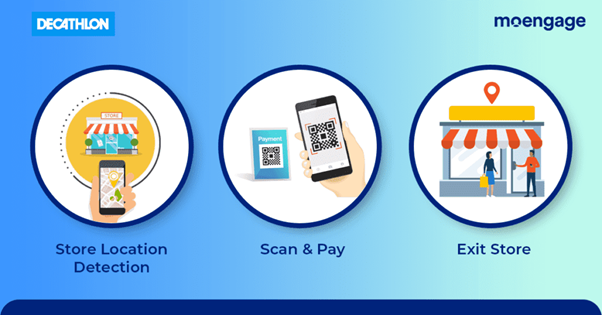By Ankita Kaushik, Content Marketer at MoEngage
In the first part of this series, we discussed why the need to focus on connected retail has risen dramatically in the last few years. We also discussed the advantages of offering a connected experience. In this part (Part 2), we will discuss one brand that has been doing connected retail right—Decathlon.
The COVID-19 pandemic led to greater awareness about health and fitness and the need to live a healthy lifestyle. As a sports and fitness accessory brand, Decathlon was quick to recognize the opportunity in the market.
However, with lockdowns and social distancing coming into the picture, they knew that their tried and tested in-store experience format would not be enough. Enter omnichannel shopping.
Decathlon understood the necessity of making sports and sports accessories accessible to the masses while providing a safe and contactless shopping experience. Hence, the team decided to bridge the gap between their online and offline product marketing strategies by creating an omni-experience for the user, with a custom Decathlon app.
Here’s the checklist that Decathlon used to execute and optimize its omnichannel shopping experience across channels.
Optimizing the Omnichannel Experience
Apart from offering a completely online shopping experience, there were two crucial advantages of the app:

A. The Scan-and-Pay Approach
For customers who wanted an in-store shopping experience, the Decathlon app could be used to scan and pay for their individual items, eliminating the usual queues and unnecessary physical interactions involved at a typical checkout counter.
The app was designed to offer a guided, step-by-step process that took customers along a seamless buying journey, achieving the twin goals of customer satisfaction as well as safety.
Some of the additional features of the app included store location detection and QR code scans at the exit to validate that the appropriate transaction was processed.
B. Contactless Pick-Up from the Store
Decathlon offered easier and faster purchasing for the customers who opted for the store pick-up option. Customers could pick up their purchases either via a drive-thru or at the socially distanced waiting zone, which enabled the store to maintain health safety guidelines while ensuring a faster and smoother checkout experience.
The primary advantages of this format were zero-contact shopping, faster lead time, increased cost-effectiveness by eliminating the delivery costs, and absolute safety with sanitization of all products.
This move from an exclusive in-store retail experience to an omnichannel environment was a calculated and proactive approach by Decathlon, as the company realised the need for omnichannel marketing to keep product sales up.
The company identified all the different channels where their target customers liked to shop, like retail outlets, eCommerce platforms like the app and website, social platforms like Facebook and Instagram, and direct marketing communication platforms like push notifications and email.
All the user details gathered at the time of purchase were mutually transferable between online and offline channels, irrespective of where the data was collected. In addition, they also acquired user feedback at every step to eliminate unnecessary buyer friction, thus creating an extremely smooth buyer journey across multiple platforms.
The end result? Shoppers experienced a seamless buying journey, irrespective of their buying platform. There was no jarring disconnect to break the buyer flow, thereby cementing Decathlon as a firm favourite among sports brands! Stay tuned for part 3 of this article series—customer conversions with connected retail.


